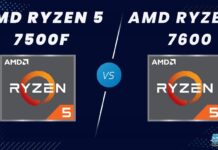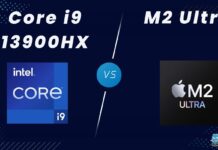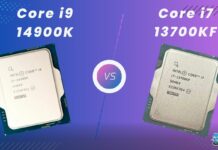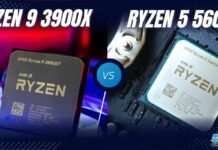AMD Ryzen 5 5600X3D
Rated: 7.5/10
Intel Core i5 13600K
Rated: 7/10
Pros And Cons
| CPU | Pros | Cons |
|---|---|---|
| Ryzen 5 5600X3D | ✅High Price-to-Performance Ratio ✅ Perfect for your First PC Built | ❌ Lower Specs such as Cores, Threads & Clock Speeds |
| Core i5-13600K | ✅ Slightly Higher Performance ✅ Lower Temperatures | ❌ Unjustified Price Point |
- Our benchmarks showed that the Core i5 13600K has higher gaming performance. It was about 2.7% faster than the 5600X3D on average.
- Regarding thermal efficiency, the Ryzen 5 5600X3D drew 35% less power but ran 13% hotter.
- As of early August, the Ryzen 5 5600X3D is about 30% cheaper, according to the current market price, than Intel’s i5 13600K.
- We recommend the Ryzen 5 5600X3D due to its great cost-to-performance ratio. The i5 13600K is also a good CPU but in the Ryzen 5 5600X3D Vs i5 13600K, the R5 is the champion.
Comparison Table
| Specifications | AMD Ryzen 5 5600X3D | Intel Core i5 13600K |
|---|---|---|
| Core Architecture | Zen 3 | Raptor Lake |
| Processing Node | TSMC 7nm | Intel 10nm |
| Socket | AM4 | Intel Socket 1700 |
| Launch Date | July 2023 | September 2022 |
| Best Motherboards | Motherboards For Ryzen 5 5600X3D | Motherboards For i5 13600K |
| Best Coolers | CPU Coolers Fore Ryzen 5 5600X3D | CPU Coolers For i5 13600K |
Architectural Differences
- Clock Speeds: The E-cores on the 13600K can clock from 2.6GHz and up to 3.9GHz, while the P-cores have a base and boost frequency of 3.5GHz and 5.1GHz. In contrast, the 5600X3D has a base and boost clock of 3.3GHz and 4.4GHz.
- Memory Support: The 13600K supports DDR4 and DDR5 memory with speeds up to 3200 MT/s and 5600 MT/s, respectively. In contrast, the 5600X3D only supports DDR4 memory at 3200 MT/s.
- TDP: The AMD’s Ryzen 5 5600X3D has a TDP of 105 watts; on the other hand, the Core i5 1300K has 125 Watts.
- Other Technologies: The 13600K employs Intel’s big.LITTLE hybrid cores architecture, whereas the 5600X3D uses AMD’s 3D-V cache, which allows the processor to stack a large amount of cache vertically.
In the Ryzen 5 5600X3D vs Core i5 13600K comparison, we will see if this new processor from AMD can keep up with a more modern and expensive offering from Intel. If the legacy of all the other 3D V-Cache CPUs is anything to go by, this processor should punch way above its weight in gaming performance.
Gaming Benchmarks – 1080p
Now that we’ve cleared the difference between these processors in terms of hardware, it’s time to see how they keep up against each other in real-world gaming.
Testing Rig
- Motherboard (Intel): MSI PRO Z790-A WIFI DDR4
- Motherboard (AMD): ASUS ROG X570 Crosshair VIII Hero
- Memory: Corsair Vengeance RGB Pro (2x16GB) – 3200MHz
- CPU Cooler: be quiet! Dark Rock Pro 4
- GPU: GeForce RTX 4090 24GB
- SSD: Sabrent Rocket 4 Plus G 2TB
- Power Supply: Enermax Revolution D.F. X 1050W
- OS: Windows 11
Cyberpunk 2077

- Kicking these tests off, the Ryzen 5600X3D is slower than the 13600K, though not considerably. The 5600X3D managed an average framerate of 111 FPS, whereas the 13600K had a noticeably higher framerate of 124 FPS.
- Switching gears to the 1% lows, the 5600X3D maintained a minimum of 81 FPS, whereas the 13600K outperformed it with 97 FPS.
Hogwarts Legacy

- Another modern demanding game, with all the settings cranked up, and ray tracing turned up, the 5600X3D managed to get an average framerate of 62 FPS, whereas the 13600K had an average of 68 FPS.
- 1% lows were also relatively similar on both processors, though the dips at such low framerates are noticeable. The i5 13600K had a 1% low of 58 FPS, whereas the 5600X3D had lows of 53 FPS.
Forza Horizon 5

- Coming to this brilliantly optimized title, we see our first win for the Ryzen. It averaged a framerate of 206 FPS, whereas the 13600K averaged 194 FPS.
- 1% lows were also smoother on the X3D chip, maintaining about 133 FPS. The i5 came in a little slower at about 122 FPS.
The Last Of Us

- Surprisingly, The Last Of Us ran great on both test benches. The winning streak of the Ryzen ended in this game, with the 13600K averaging a framerate of 216 FPS, whereas the Ryze 5 5600X3D averaged about 194 FPS.
- The 5600X3D also lost its winning streak in 1% lows, maintaining a minimum framerate of 107 FPS compared to 122 FPS on the 13600K.
Microsoft Flight Simulator

- The 5600X3D returned to shape in this game, beating out the 13600K. It averaged 105 FPS, whereas the 13600K was slightly behind at 92 FPS.
- 1% lows were also higher on the X3D processor, maintaining 89 FPS compared to 76 FPS on the Core CPU.
Horizon Zero Dawn

- The 5600X3D again outperformed the 13600K in Horizon Zero Dawn, averaging 219 FPS compared to the slightly lower 207 FPS of the i5.
- 1% lows were also more pleasant on the 5600X3D. It maintained 166 FPS, whereas the 13600K maintained closer to 155 FPS.
Hitman 3

- Hitman 3 performed better on the 13600K. The processor averaged 215 FPS, while the 5600X3D had a noticeably lower framerate of around 189 FPS.
- As expected, the 13600K was also ahead in 1% lows. It maintained lows of around 145 FPS, whereas the 5600X3D fell behind with lows of 127 FPS.
Spider-Man Miles Morales

- There were some noticeable differences in this game. The 5600X3D averaged a lower 81 FPS, whereas the 13600K averaged 92 FPS.
- 1% lows were also better on the i5. It maintained 68 FPS, whereas the 5600X3D had lows of around 59 FPS.
Overall Gaming Performance
| Processor | Average FPS | 1% Lows |
|---|---|---|
| Ryzen 5 5600X3D | 📈 155 | 📉 108 |
| Intel Core i5 13600K | 📈 159 | 📉 110 |
| Winner: Intel Core i5 13600K | ||
The 5600X3D and the 13600K were quite neck-to-neck results since the difference in the average framerates between the CPUs was only 2.5%, whereas the i5-13600K was superior. The results were similar regarding the 1% lows, with i5-13600K taking the lead at 1.8%.
Power Consumption
| Game | Ryzen 5 5600X3D (W) | Intel Core i5 13600K (W) |
|---|---|---|
| Cyberpunk 2077 | 61 | 84 |
| Hogwarts Legacy | 43 | 61 |
| Forza Horizon 5 | 44 | 62 |
| The Last Of Us | 67 | 94 |
| Microsoft Flight Simulator | 53 | 59 |
| Horizon Zero Dawn | 63 | 81 |
| Hitman 3 | 43 | 76 |
| Spider-Man Miles Morales | 61 | 83 |
| Average Power Consumption | 54 ⚡️ | 75 ⚡️ |
| Winner: AMD Ryzen 5 5600X3D | ||
As for power consumption, the Ryzen 5 5600X3D showed its dominance by having relatively lower power consumption than the Core i5-13600K. The difference is 31.2%, whereas the Ryzen 5 5600X3D is the power-efficient option.
Thermal Efficiency
| Game | Ryzen 5 5600X3D (°C) | Intel Core i5 13600K (°C) |
|---|---|---|
| Cyberpunk 2077 | 57 | 52 |
| Hogwarts Legacy | 56 | 48 |
| Forza Horizon 5 | 60 | 52 |
| The Last Of Us | 62 | 55 |
| Microsoft Flight Simulator | 58 | 57 |
| Horizon Zero Dawn | 61 | 50 |
| Hitman 3 | 56 | 57 |
| Spider-Man Miles Morales | 59 | 54 |
| Average Gaming Temperature | 58.4 🌡️ | 53.1 🌡️ |
| Winner: Intel Core i5 13600K | ||
Despite having better power efficiency, the Ryzen 5 5600X3D failed to have better thermal efficiency. On the other hand, the Core i5-13600K displayed better temperatures and was 13.5% thermally efficient than the Ryzen 5 5600X3D.
Price And Value
| CPU | MSRP | Current Price |
|---|---|---|
| Ryzen 5 5600X3D | 💲229 | 💲154 |
| Core i5-13600K | 💲329 | 💲294 |
| Price Difference | 35.4% | 62.5% |
The current prices of both processors have decreased, with a 39.1% reduction in Ryzen 5 5600X3D’s price and an 11.2% reduction in i5-13600K’s price. To compare the latest prices of both, the Ryzen 5 5600X3D stands tall as the more affordable option as it is 62.5% cheaper than the Core i5 13600K.
Ryzen 5600X3D Vs Core i5 1300K: Which One Would We Recommend?
Ryzen 5600X3D: On average, the Ryzen 5600X3D’s performance is extremely close to that of its rival. This, paired with the lower price point, makes it the best affordable option you should have. Additionally, it showed better power efficiency, which adds a cherry on top of the cake.
Core i5-13600K: The Core i5-13600K showed better temperatures and had a little edge in terms of performance when compared to the Ryzen 5600X3D. But its close performance doesn’t justify the higher price point, and that’s why we don’t recommend you get it if you compare it to the Ryzen 5600X3D.
All in all, it’s reasonable to get the Ryzen 5600X3D due to its better price-to-performance ratio. However, the Core i5-13600K is an excellent processor itself, and it would be better to compare it to other CPUs to see its potential.
Frequently Asked Questions
The 5600X3D is a binned-down 5800X3D, specifically made from chips that did not perform as well as expected. Because of this, AMD did not have enough stock for a global release.
Yes, the 13600K CPU can overclock quite well, though the 5600X3D is sensitive to changes in voltages.
Yes, but only in low-power applications. In high-power applications, the performance cores kick in, in addition to the efficiency cores, making the CPU draw more power on the whole.
More From Ryzen 5 5600X3D:
More From Intel i5-13600K:
Thank you! Please share your positive feedback. 🔋
How could we improve this post? Please Help us. 😔
[Comparisons Expert]
Shehryar Khan, a seasoned PC hardware expert, brings over three years of extensive experience and a deep passion for the world of technology. With a love for building PCs and a genuine enthusiasm for exploring the latest advancements in components, his expertise shines through his work and dedication towards this field. Currently, Shehryar is rocking a custom loop setup for his built.
Get In Touch: shehryar@tech4gamers.com







![Core i9-12900K vs Ryzen 7-5800X3D [We Tested 11 Games] Intel i9-12900K vs Ryzen 7-5800X3D](https://tech4gamers.com/wp-content/uploads/2022/06/Intel-i9-12900K-vs-Ryzen-7-5800X3D-218x150.jpg)